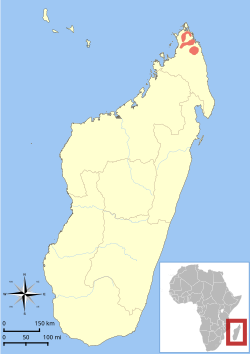Description
The Amber Mountain fork-marked lemur is light grey on the dorsal and ventral areas of its body, with a thick, dark crown, dorsal midline stripe, and tail, as well as its hands and feet.
No official body measurements have been published for the Amber Mountain fork-marker lemur, however unpublished research by E. E. Louis Jr suggests that three of the species (2 male 1 female) from Montagne d'Ambre had an average head-body length of 27.2 cm (±0.4 cm), a tail length o-34.4 cm (±0.2 cm), and an average weight of 387g (±35g).
The species is similar to several other nocturnal lemurs, including Microcebus, Cheirogaleus, and Lepilemur, however they are mainly differentiated from Microcebus by its difference in size, and from all else the forked pattern on the crown, the very loud and distinctive vocalizations, and the unusual head-bobbing movements. [5]
Habitat
The Amber Mountain fork-marked lemur lives in north Madagascar, in the regions of Montagne d'Ambre and Ankarana, specifically in the Montagne d'Ambre National Park, and is also present in Ankarana National Park, two special reserves (Analamerana and Forêt d'Ambre), and in the Sahafary Classified Forest. A group of lemurs in the genus Phaner have been spotted in Dariana, however it has not been identified as to whether it belongs to the species Electromontis, or, more likely, is an entirely new species.
The Amber Mountain fork-marked lemur mainly inhabits both the wet and dry forest. [5]
This page is based on this
Wikipedia article Text is available under the
CC BY-SA 4.0 license; additional terms may apply.
Images, videos and audio are available under their respective licenses.

